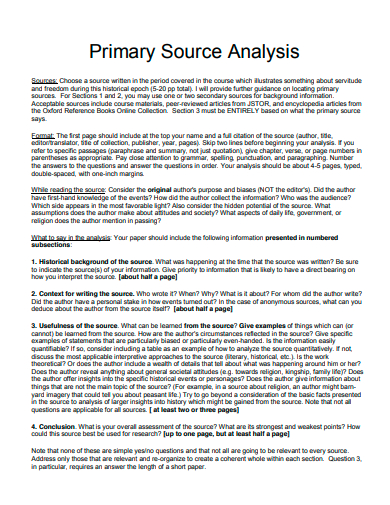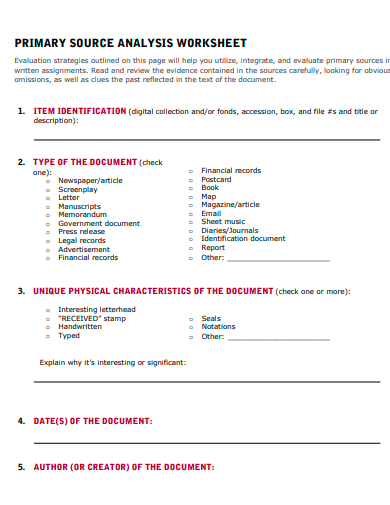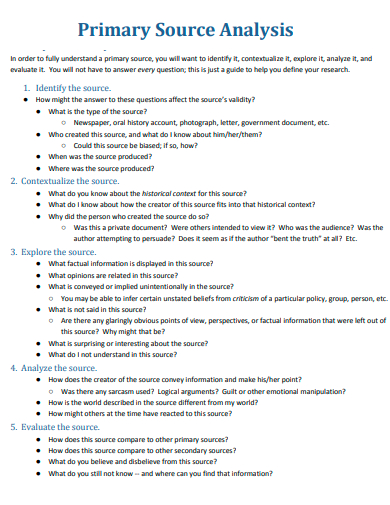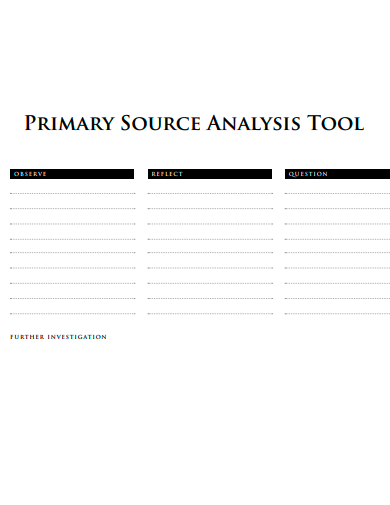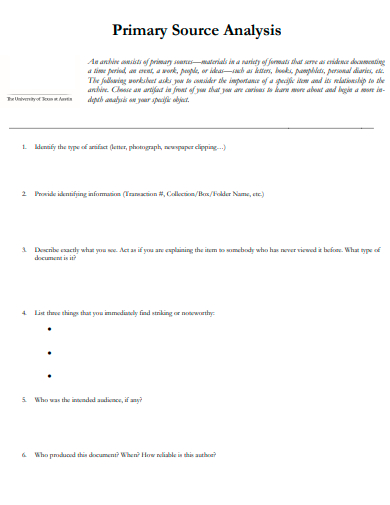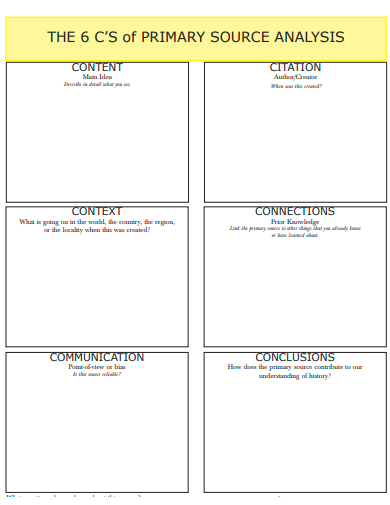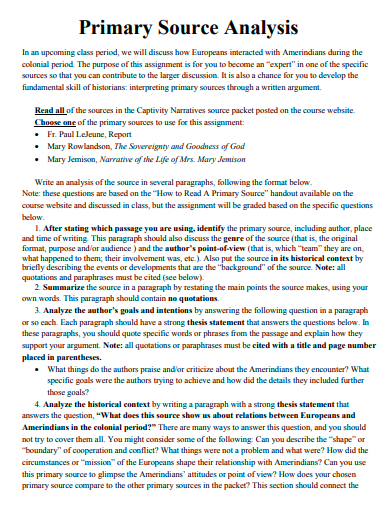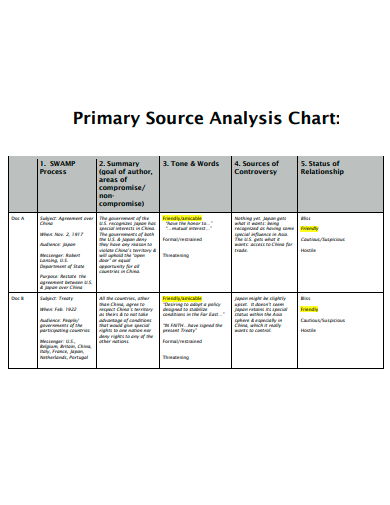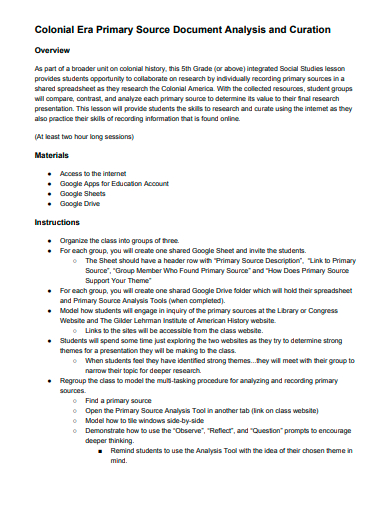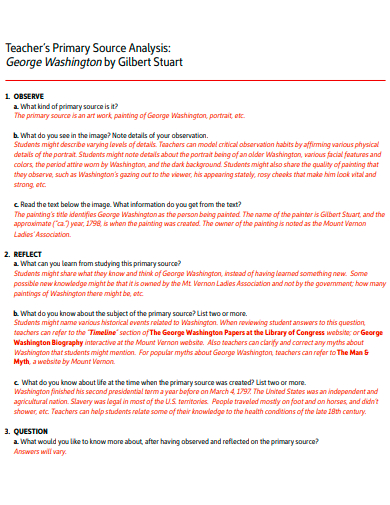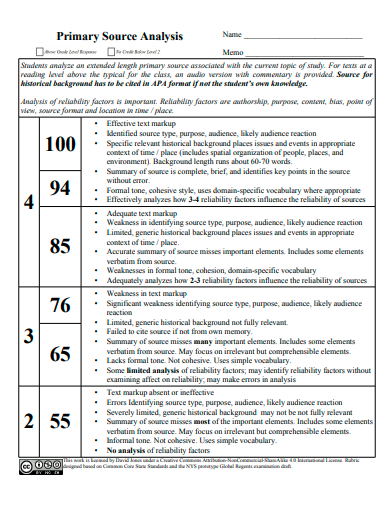Primary sources refer to the documents or raw materials of history which serves as a piece of evidence of an event or time created by people. These documents are original materials regardless of their format and have not been modified by the interpretation of an individual as well as providing original thought or new data. Primary sources can be in a form of informal or formal letters, meeting minutes, diaries, artifacts, photographs, interview summaries, and AV recordings. Other examples of primary sources are oral histories, journal entries or newspaper articles, and autobiography outlines.
FREE 10+ Primary Source Analysis Samples
1. Primary Source Analysis Template
2. Primary Source Analysis Worksheet
3. Primary Source Analysis Example
4. Primary Source Analysis Tool
5. Basic Primary Source Analysis
6. Formal Primary Source Analysis
7. Primary Source Analysis in PDF
8. Primary Source Analysis Chart
9. Primary Source Document Analysis
10. Teachers Primary Source Analysis
11. Sample Primary Source Analysis
What is a Primary Source Analysis Template?
A primary source analysis template is a document used to outline pieces of information related to historical events or a period which was originated at the same time as the event. It is used to gather words, thoughts, and emotions from the people of the past while also enabling you to understand what happened and the reasons why it happened. Books are not the only form of primary sources but also written documents and items created at that certain event or period such as maps, official records like marriage and birth certificates, and personal belongings such as coins, tools, and garments.
How to Write a Primary Source Analysis?
In any research paper in any field, primary sources are the most valuable tool. By analyzing these sources, researchers can determine their starting point and establish it within a historical event, determine the necessary areas for the research, or support a thesis statement. Analyzing a primary source enables the understanding of the material’s intent and determines if it is only to provide a record of certain events or created to analyze events to form an argument.
Step 1: Read the Material or Document
If you gathered your primary source using an archive or online origin, you might find a short summary of the document but if you are using a primary source that your professor provided you, you might find an opening statement or an introduction.
Step 2: Summarize as you Read
Primary sources often use confusing terminologies especially if you are analyzing older documents. There are chances that you will encounter words and phrases that are not familiar to you and summarizing as you read the material will help you track what the document is conveying.
Step 3: Ask Relevant Questions and Make Connections
As you read the document, list down questions about the things that do not make sense. Try to make connections to other documents and lectures so you can easily understand their context.
Step 4: Determine the Reliability of the Source
You can determine the reliability of your primary source by writing down the biases you spot, comparing your primary source to secondary sources, researching who the author is, identifying the purpose and target audience of the primary source, and the event or period when the primary source was created or written.
FAQs
What are the elements that you need to analyze when interpreting primary sources?
If you are reading a primary source, it is important to under the topic or event it’s discussing as well as the people involve and what messages they are trying to convey. After understanding its scope, you can perform a detailed analysis of the author, target audience, and reliability of your primary source.
What is the advantage of teaching with primary sources?
With primary sources, students can understand the events that happened in the past on a personal level. It also helps in improving the student’s critical thinking and analytical skills by exposing them to various perspectives and significant events in both the present and the past.
How do I write an essay based on a primary source?
When writing an essay outline using a primary source, you can start by formulating an argument or question, providing historical context, analyzing your sources, providing statements to support your argument, making a conclusion, and citing your sources.
Analyzing and acknowledging the documents created or written from historical periods or events is one of the most important elements of social studies. A primary source analysis template or analysis worksheet is used to document the relevant evaluation of photographs, artworks, artifacts, and other materials from historical events.
Related Posts
FREE 10+ Risk Assessment Plan Samples in MS Word Google ...
FREE 10+ Food Mindmap Samples in Word Google Docs | Google ...
FREE 3+ Data Analysis Research Plan Samples in PDF MS Word ...
FREE 10+ Sample Opportunity Analysis Templates in PDF MS Word
FREE 10+ Retail Gap Analysis Samples in PDF
FREE 5+ Market Research & Analysis Report Samples in PDF
FREE 8+ Sample Statement Analysis Templates in PDF MS Word ...
FREE 19+ Cost Benefit Analysis Templates in Google Docs MS ...
FREE 20+ Research Paper Outlines in PDF MS Word
FREE 11+ Financial Statement Samples in Google Docs MS Word ...
FREE 10+ Elementary Research Report Samples in PDF MS Word
FREE 8+ Market Research Samplesin PDF MS Words | Apple Pages
FREE 10+ Sample Opportunity Analysis Templates in PDF MS Word
FREE 10+ Retail Gap Analysis Samples in PDF
FREE 5+ Market Research & Analysis Report Samples in PDF

